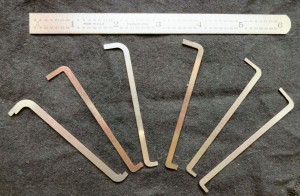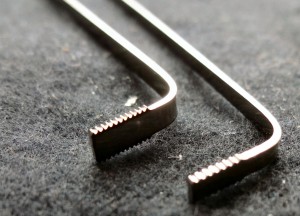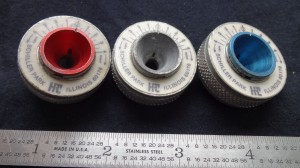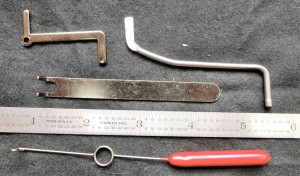Yes, that’s the right name for them. Despite more appropriate terminology like rotational force, centripetal force, tangential force, or torque the community calls it “tension”. Deal with it. There are several types of tension wrenches but they are usually categorized by their placement in the keyway.
Bottom of the Keyway (BOK)
 These are the most common tensioners and are included in almost every beginner kit. There are three standard widths (0.14″, 0.12″, and 0.10″) which, coincidentally, are the same as the inserts found in most automobile windshield wipers, so making your own is too easy.
These are the most common tensioners and are included in almost every beginner kit. There are three standard widths (0.14″, 0.12″, and 0.10″) which, coincidentally, are the same as the inserts found in most automobile windshield wipers, so making your own is too easy.
In selecting your tension tool try to fit in the narrowest tool possible that gives good tension and doesn’t jam between the core and lock body. This is a very easy mistake to make. Just jiggle the tensioner and make sure the core moves freely before inserting the pick. BOK tensioners come with long, short, straight, bent, and twisted handles. Your choice is 100% preference, as they all do precisely the same thing: tension.
Top of the Keyway (TOK)
 Beginner kits don’t come with TOK tensioners so most noobs don’t bother experimenting with them. I think that’s a shame because TOK offers several advantages over BOK. The TOK tools are usually double ended, with one end for flush faced locks, and the longer one for counter-sunk lock faces.
Beginner kits don’t come with TOK tensioners so most noobs don’t bother experimenting with them. I think that’s a shame because TOK offers several advantages over BOK. The TOK tools are usually double ended, with one end for flush faced locks, and the longer one for counter-sunk lock faces.
They come in two standard widths: 0.040” and 0.050”, but there are many other thicknesses available. You’ll probably need at least the two standard ones. They are short and easy to use in a recessed doorway without being obstructed by either the knob or door jamb, which can be a problem with BOK tools. The TOKs come with either serrated or smooth teeth. It probably doesn’t make much difference which you choose because the performance of both, at least to me, is identical. If you’re worried about scratching the keyway or pick the same lock over and over, go with the smooth version so it doesn’t mar the keyway. The TOKs also have a depth limiter that prevents the tool from resting against the first pin and locking it in place. Finally, TOK tools fit flat into my every day carry kit, while BOKs don’t. I am a huge fan of the TOKs and urge you to give them a try.
Serrated Tensioners
 These are relatively new tools and come in two forms. Both Sparrows and Peterson sell “Z” shaped serrated tools in thicknesses ranging from 0.015” up to 0.030”. I have not found these particularly useful. The serrated tool I DO like is the traditional “L” shape with serrated teeth.
These are relatively new tools and come in two forms. Both Sparrows and Peterson sell “Z” shaped serrated tools in thicknesses ranging from 0.015” up to 0.030”. I have not found these particularly useful. The serrated tool I DO like is the traditional “L” shape with serrated teeth.
They come in three different widths and I find these VERY useful for tensioning high security European locks that my thick TOK will not fit into.
Circular Tensioners
 Several years ago these were very popular for a short time. They DO look cool, but in practice they are crap. The prongs that fit into the keyway need to be constantly adjusted and break easily.
Several years ago these were very popular for a short time. They DO look cool, but in practice they are crap. The prongs that fit into the keyway need to be constantly adjusted and break easily.
The tension reading scale on their face was wildly inaccurate and varied from use to use. Because they sit in front of the lock they robbed the picker of valuable working space, requiring you to reach at least 0.25” further into the keyway to access pins. The prongs also have a bad habit of slipping out at random, dropping all the pins you’ve picked and, adding insult to injury, marring the lock face with deep gouges. Oh yes, they are also very expensive. Obviously, I’m not a fan of circular tension tools.
Custom and Oddball Tensioners
 Custom made tensioners are the last category that I’ll lump everything else into. These include feather touch, shutter lock tensioners, wafer lock tensioners, double sided tensioners (Falle-Safe), and homemade tensioners.
Custom made tensioners are the last category that I’ll lump everything else into. These include feather touch, shutter lock tensioners, wafer lock tensioners, double sided tensioners (Falle-Safe), and homemade tensioners.
One of the most popular tension tools in the “oddball” category is the set of tensioners to pick the Best lock to the control shear. Years ago the cores had a series of holes in the control sleeve that these tensioner’s “pegs” would fit into. It worked! Using these tools you had a better chance of hitting the control shear line allowing you to remove the core and re-use the padlock or SFIC mortise body.
 Unfortunately, a few years after this technique was discovered Best changed their manufacturing process to leave out the sleeve holes, so this tool no longer works. Still, thousands are sold every year so I guess a lot of folks either don’t know that or are working on some really old cores.
Unfortunately, a few years after this technique was discovered Best changed their manufacturing process to leave out the sleeve holes, so this tool no longer works. Still, thousands are sold every year so I guess a lot of folks either don’t know that or are working on some really old cores.
In my view these are all gimmicks and tension no better, and sometimes worse, than the ones described above.